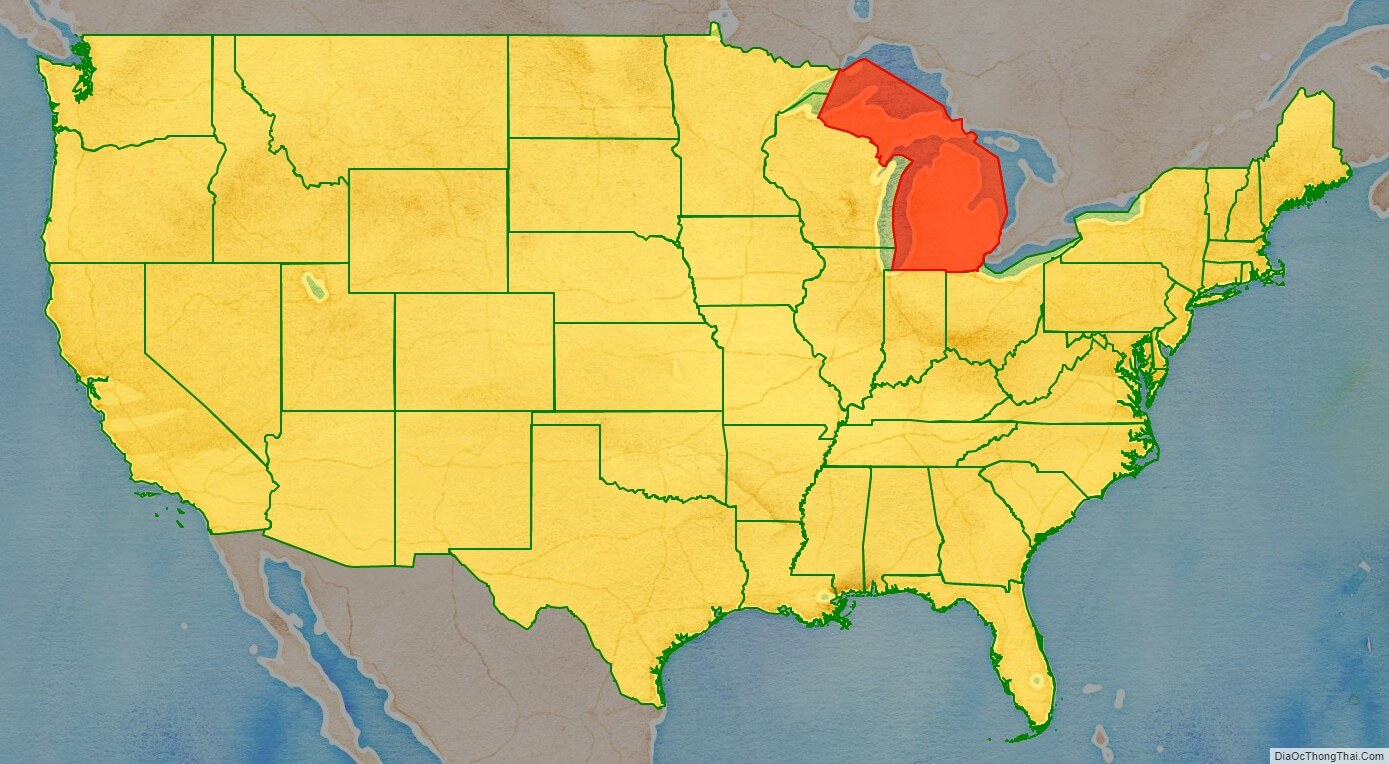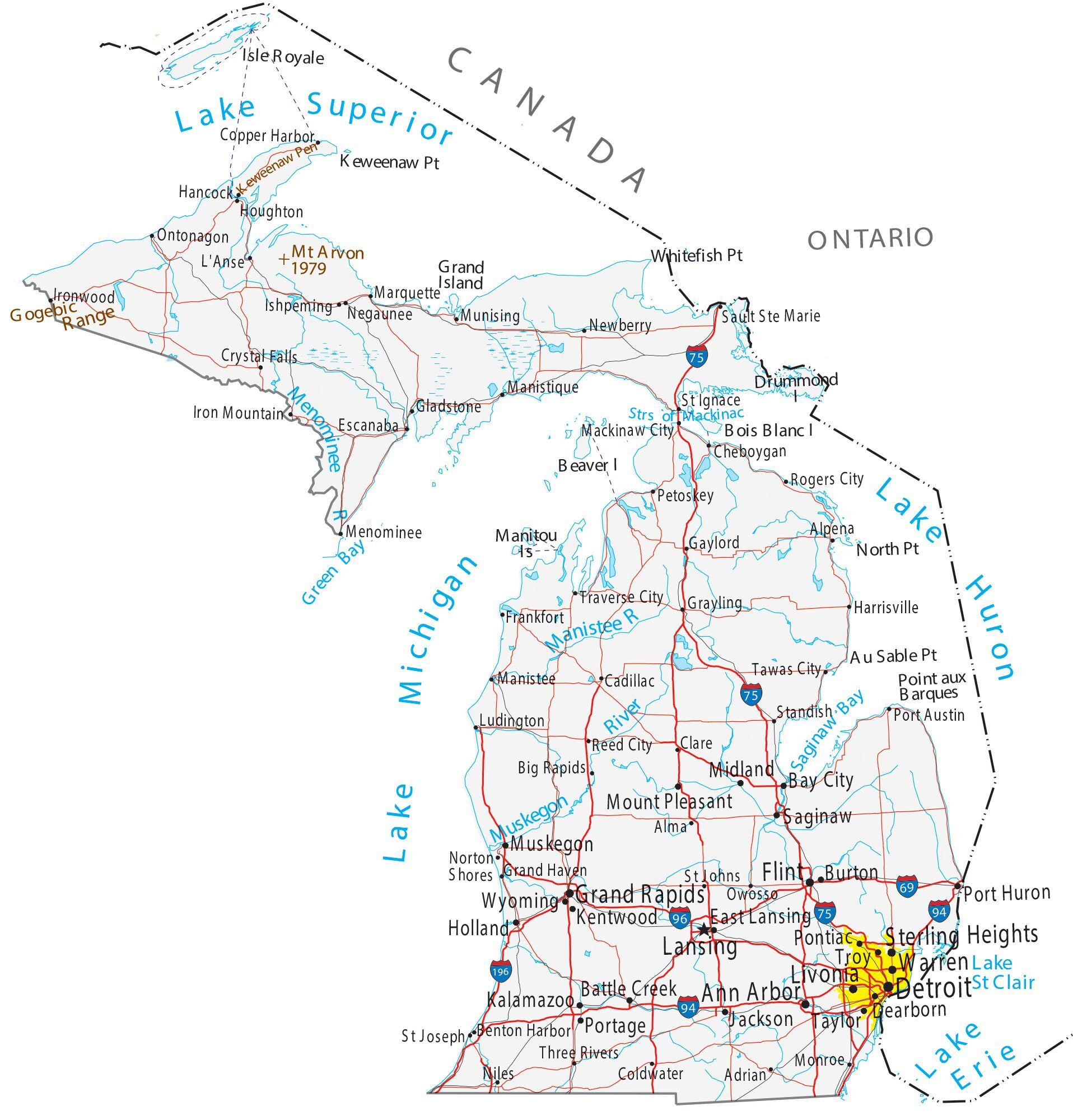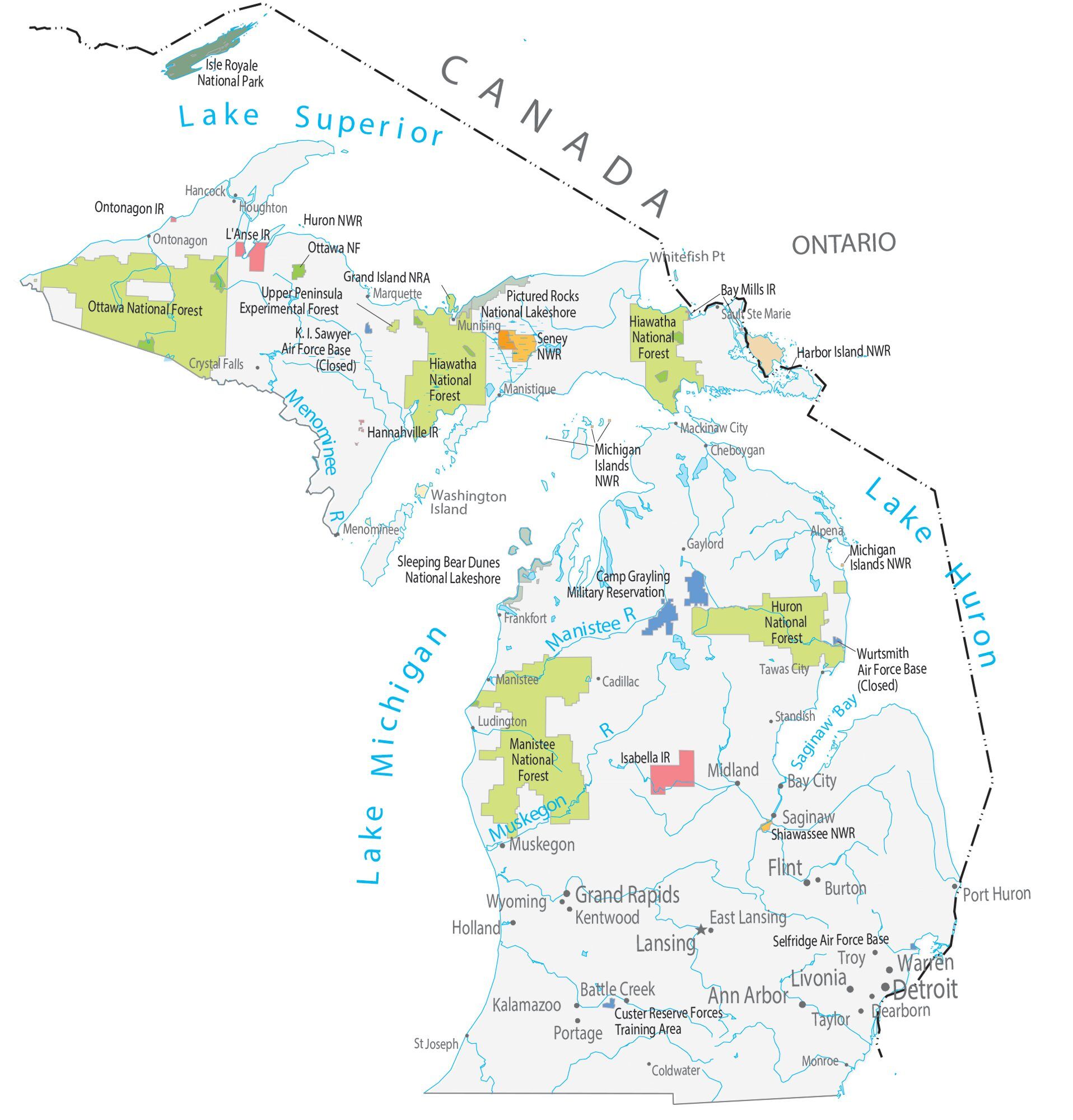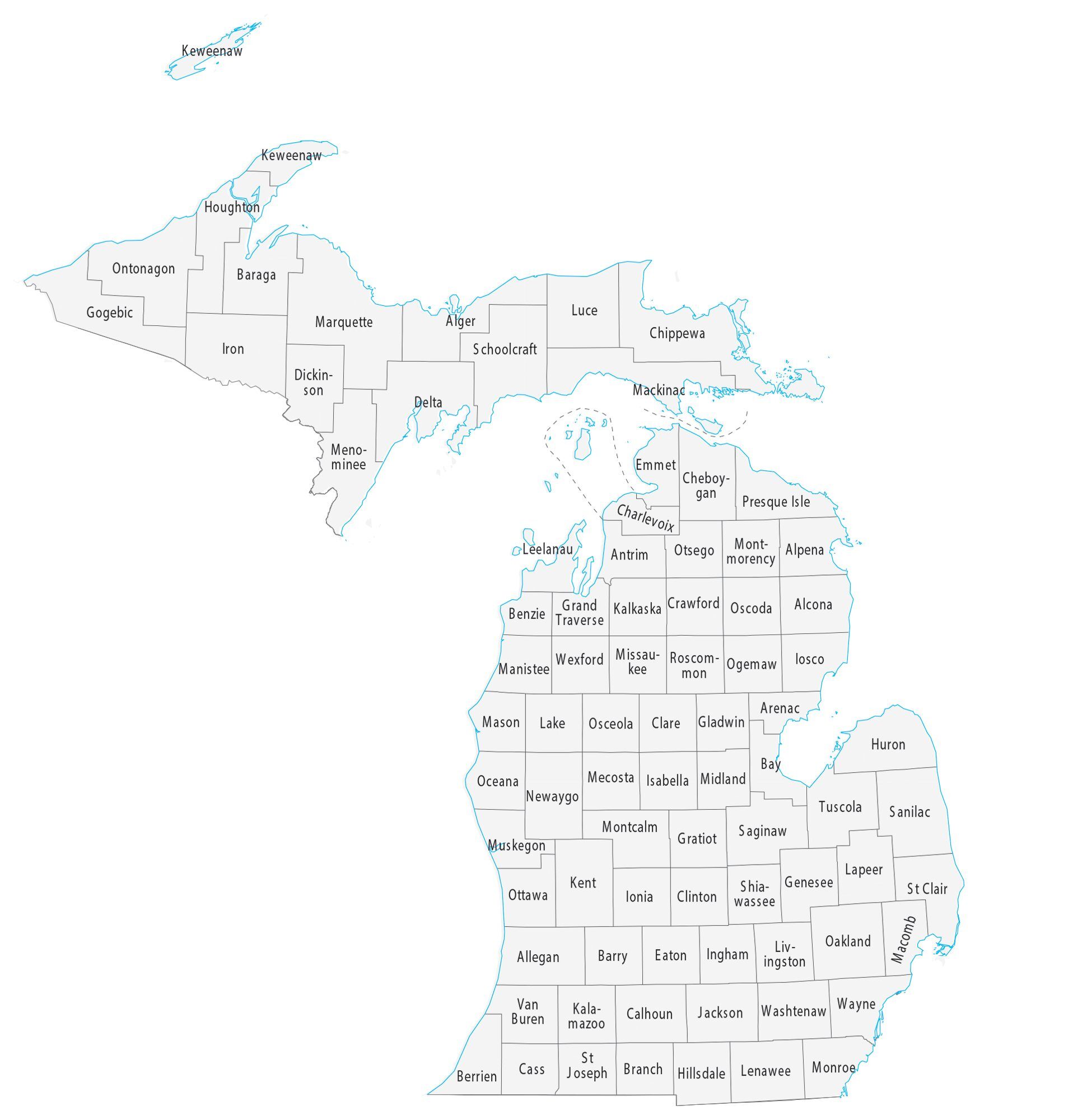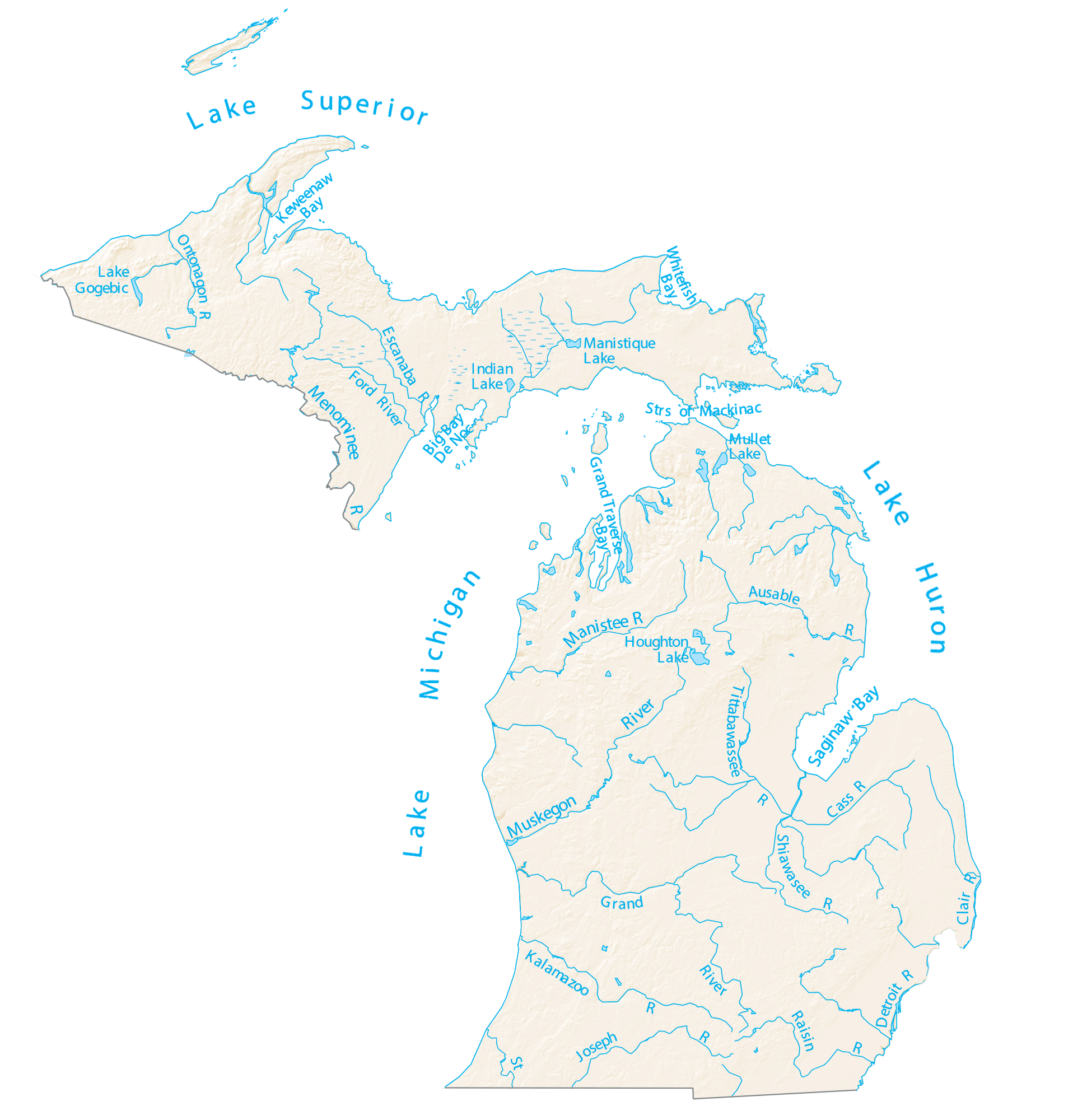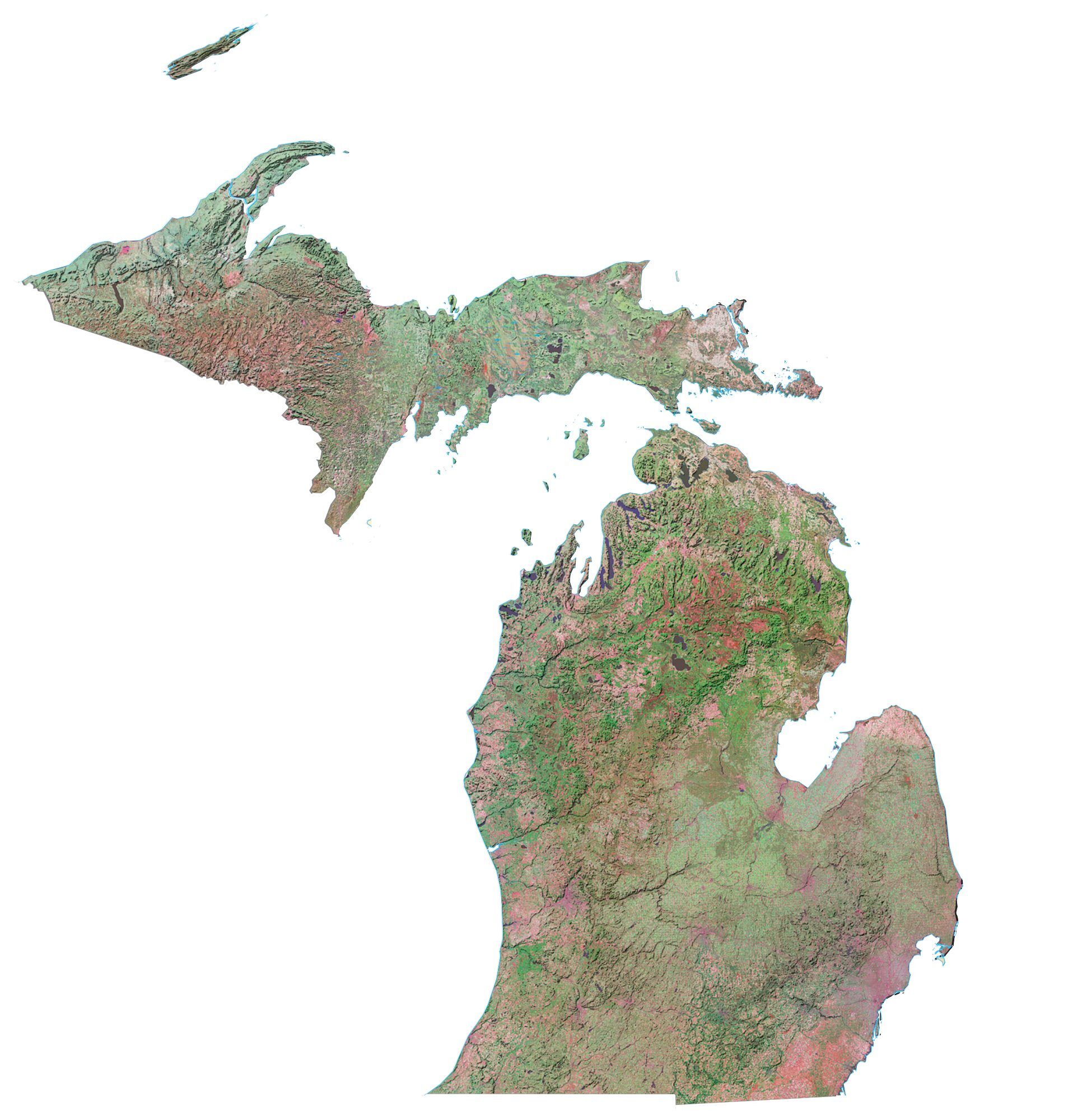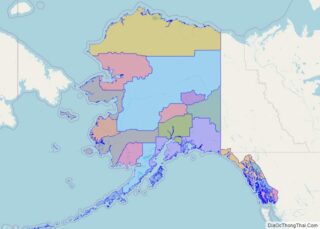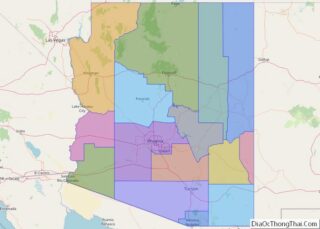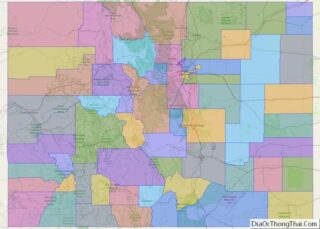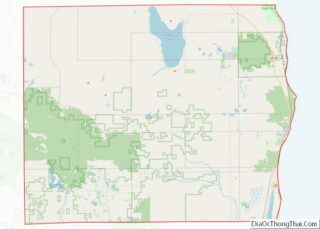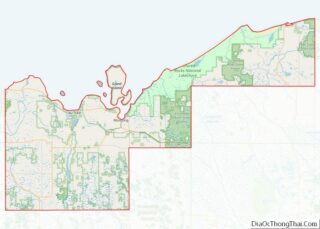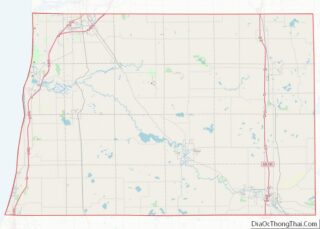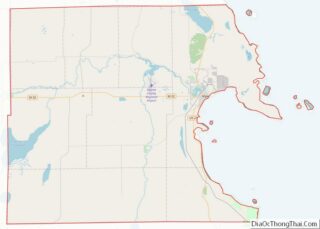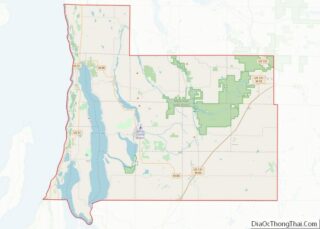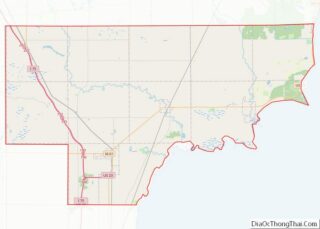Michigan (/ˈmɪʃɪɡən/ (listen)) is a state in the Great Lakes region of the upper Midwestern United States. It is bordered by Minnesota to the northwest, Wisconsin to the southwest, Indiana and Ohio to the south, and Lakes Superior, Huron, and Erie (which border the Canadian province of Ontario) to the north and east. With a population of nearly 10.12 million and an area of nearly 97,000 sq mi (250,000 km), Michigan is the 10th-largest state by population, the 11th-largest by area, and the largest by area east of the Mississippi River. Its capital is Lansing, and its largest city is Detroit. Metro Detroit is among the nation’s most populous and largest metropolitan economies. Its name derives from a gallicized variant of the original Ojibwe word ᒥᓯᑲᒥ (mishigami), meaning “large water” or “large lake”.
Michigan consists of two peninsulas. The Lower Peninsula resembles the shape of a mitten, and comprises a majority of the state’s land area. The Upper Peninsula (often called “the U.P.”) is separated from the Lower Peninsula by the Straits of Mackinac, a five-mile (8 km) channel that joins Lake Huron to Lake Michigan. The Mackinac Bridge connects the peninsulas. Michigan has the longest freshwater coastline of any political subdivision in the United States, being bordered by four of the five Great Lakes and Lake St. Clair. It also has 64,980 inland lakes and ponds. Michigan has the second-most water of any state, behind only Alaska.
The area was first occupied by a succession of Native American tribes over thousands of years. In the 17th century, French explorers claimed it as part of the New France colony, when it was largely inhabited by indigenous peoples. French and Canadian traders and settlers, Métis, and others migrated to the area, settling largely along the waterways. After France’s defeat in the French and Indian War in 1762, the region came under British rule. Britain ceded the territory to the newly independent United States after its defeat in the American Revolutionary War.
The area was part of the larger Northwest Territory until 1800, when western Michigan became part of the Indiana Territory. Michigan Territory was formed in 1805, but some of the northern border with Canada was not agreed upon until after the War of 1812. Michigan was admitted into the Union in 1837 as the 26th state, a free one. It soon became an important center of industry and trade in the Great Lakes region, attracting immigrants in the late 19th and early 20th centuries from many European countries. Immigrants from Finland, Macedonia, and the Netherlands were especially numerous. Migration from Appalachia and of Black Southerners as part of the Great Migration increased in the 1930s, with many settling in Metro Detroit.
Although Michigan has developed a diverse economy, in the early 20th century it became widely known as the center of the U.S. automotive industry, which developed as a major national economic force. It is home to the country’s three major automobile companies (whose headquarters are all in Metro Detroit). Once exploited for logging and mining, today the sparsely populated Upper Peninsula is important for tourism due to the abundance of natural resources. The Lower Peninsula is a center of manufacturing, forestry, agriculture, services, and high-tech industry.
| Before statehood: | Michigan Territory |
|---|---|
| Admitted to the Union: | January 26, 1837 (26th) |
| Capital: | Lansing |
| Largest city: | Detroit |
| Largest metro and urban areas: | Detroit |
| Elevation: | 900 ft (270 m) |
| Total Area: | 99,716 sq mi (250,493 km) |
| Area Rank: | 11th |
| Total Population: | 10,077,331 |
| Population Rank: | 10th |
| Population Density: | 174/sq mi (67.1/km) |
| Population Density Rank: | 17th |
| Median Household Income: | $54,900 |
| Income Rank: | 32nd |
| Demonym(s): | Michigander, Michiganian, Yooper (Upper Peninsula) |
| USPS abbreviation: | MI |
| ISO 3166 code: | US-MI |
| Website: | michigan.gov |
Online Interactive Map
Click on ![]() to view map in "full screen" mode.
to view map in "full screen" mode.
Michigan location map. Where is Michigan state?
Michigan Road Map
Michigan Map – Roads & Cities
Michigan Street Map
Michigan State Map – Places and Landmarks
Michigan Political Map
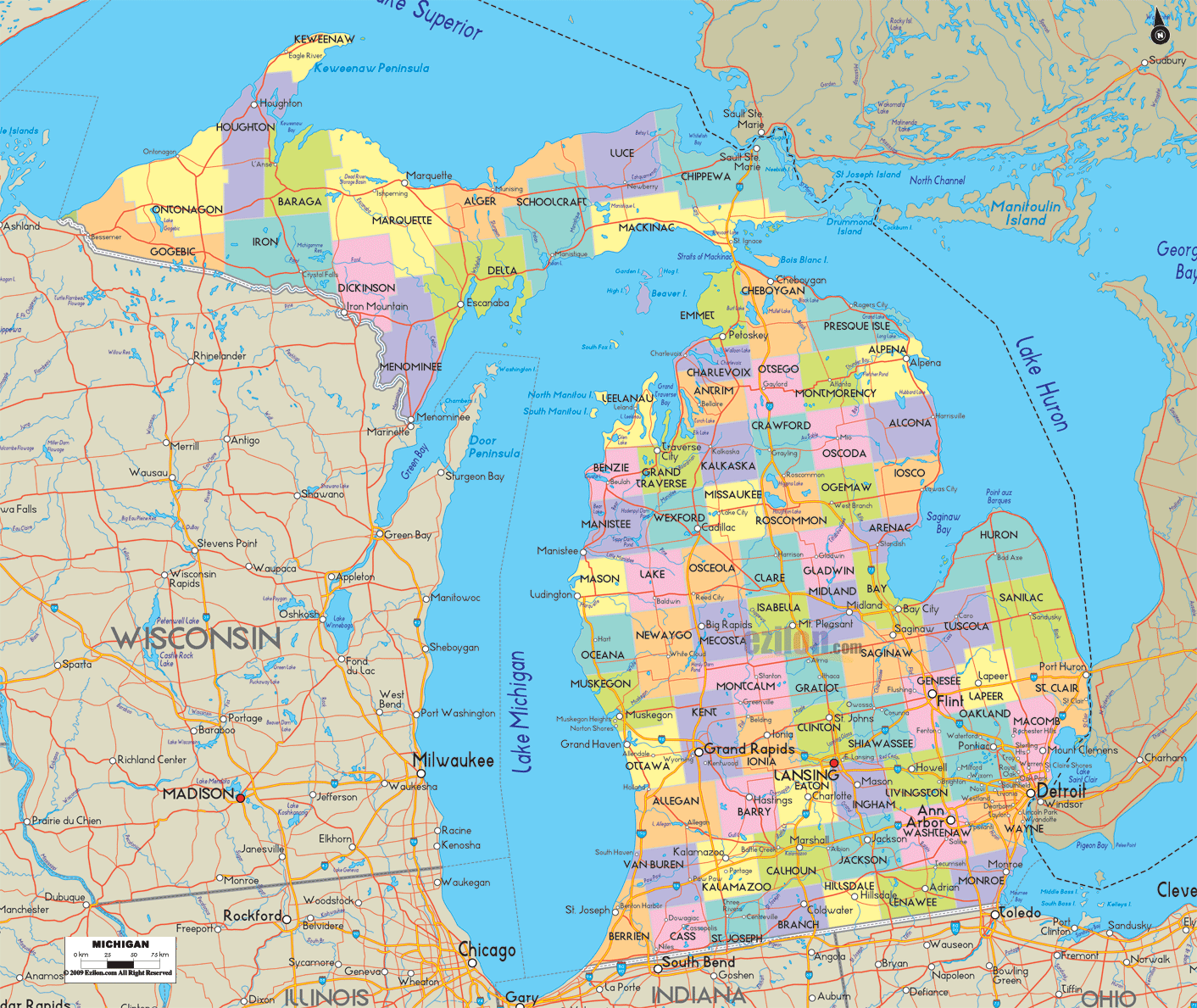
Michigan Lakes and Rivers Map
Geography
Michigan consists of two peninsulas separated by the Straits of Mackinac. The 45th parallel north runs through the state, marked by highway signs and the Polar-Equator Trail—along a line including Mission Point Light near Traverse City, the towns of Gaylord and Alpena in the Lower Peninsula and Menominee in the Upper Peninsula. With the exception of two tiny areas drained by the Mississippi River by way of the Wisconsin River in the Upper Peninsula and by way of the Kankakee-Illinois River in the Lower Peninsula, Michigan is drained by the Great Lakes-St. Lawrence watershed and is the only state with the majority of its land thus drained. No point in the state is more than six miles (9.7 km) from a natural water source or more than 85 miles (137 km) from a Great Lakes shoreline.
The Great Lakes that border Michigan from east to west are Lake Erie, Lake Huron, Lake Michigan and Lake Superior. The state is bounded on the south by the states of Ohio and Indiana, sharing land and water boundaries with both. Michigan’s western boundaries are almost entirely water boundaries, from south to north, with Illinois and Wisconsin in Lake Michigan; then a land boundary with Wisconsin and the Upper Peninsula, that is principally demarcated by the Menominee and Montreal Rivers; then water boundaries again, in Lake Superior, with Wisconsin and Minnesota to the west, capped around by the Canadian province of Ontario to the north and east.
The heavily forested Upper Peninsula is relatively mountainous in the west. The Porcupine Mountains, which are part of one of the oldest mountain chains in the world, rise to an altitude of almost 2,000 feet (610 m) above sea level and form the watershed between the streams flowing into Lake Superior and Lake Michigan. The surface on either side of this range is rugged. The state’s highest point, in the Huron Mountains northwest of Marquette, is Mount Arvon at 1,979 feet (603 m). The peninsula is as large as Connecticut, Delaware, Massachusetts, and Rhode Island combined but has fewer than 330,000 inhabitants. They are sometimes called “Yoopers” (from “U.P.’ers”), and their speech (the “Yooper dialect”) has been heavily influenced by the numerous Scandinavian and Canadian immigrants who settled the area during the lumbering and mining boom of the late 19th century.
The Lower Peninsula is shaped like a mitten and many residents hold up a hand to depict where they are from. It is 277 miles (446 km) long from north to south and 195 miles (314 km) from east to west and occupies nearly two-thirds of the state’s land area. The surface of the peninsula is generally level, broken by conical hills and glacial moraines usually not more than a few hundred feet tall. It is divided by a low water divide running north and south. The larger portion of the state is on the west of this and gradually slopes toward Lake Michigan. The highest point in the Lower Peninsula is either Briar Hill at 1,705 feet (520 m), or one of several points nearby in the vicinity of Cadillac. The lowest point is the surface of Lake Erie at 571 feet (174 m).
The geographic orientation of Michigan’s peninsulas makes for a long distance between the ends of the state. Ironwood, in the far western Upper Peninsula, lies 630 miles (1,010 kilometers) by highway from Lambertville in the Lower Peninsula’s southeastern corner. The geographic isolation of the Upper Peninsula from Michigan’s political and population centers makes the region culturally and economically distinct. Frequent attempts to establish the Upper Peninsula as its own state called “Superior” have failed to gain traction.
A feature of Michigan that gives it the distinct shape of a mitten is the Thumb. This peninsula projects out into Lake Huron and the Saginaw Bay. The geography of the Thumb is mainly flat with a few rolling hills. Other peninsulas of Michigan include the Keweenaw Peninsula, making up the Copper Country region of the state. The Leelanau Peninsula lies in the Northern Lower Michigan region. See Also Michigan Regions
Numerous lakes and marshes mark both peninsulas, and the coast is much indented. Keweenaw Bay, Whitefish Bay, and the Big and Little Bays De Noc are the principal indentations on the Upper Peninsula. The Grand and Little Traverse, Thunder, and Saginaw bays indent the Lower Peninsula. Michigan has the second longest shoreline of any state—3,288 miles (5,292 km), including 1,056 miles (1,699 km) of island shoreline.
The state has numerous large islands, the principal ones being the North Manitou and South Manitou, Beaver, and Fox groups in Lake Michigan; Isle Royale and Grande Isle in Lake Superior; Marquette, Bois Blanc, and Mackinac islands in Lake Huron; and Neebish, Sugar, and Drummond islands in St. Mary’s River. Michigan has about 150 lighthouses, the most of any U.S. state. The first lighthouses in Michigan were built between 1818 and 1822. They were built to project light at night and to serve as a landmark during the day to safely guide the passenger ships and freighters traveling the Great Lakes. See Lighthouses in the United States.
The state’s rivers are generally small, short and shallow, and few are navigable. The principal ones include the Detroit River, St. Marys River, and St. Clair River which connect the Great Lakes; the Au Sable, Cheboygan, and Saginaw, which flow into Lake Huron; the Ontonagon, and Tahquamenon, which flow into Lake Superior; and the St. Joseph, Kalamazoo, Grand, Muskegon, Manistee, and Escanaba, which flow into Lake Michigan. The state has 11,037 inland lakes—totaling 1,305 square miles (3,380 km) of inland water—in addition to 38,575 square miles (99,910 km) of Great Lakes waters. No point in Michigan is more than six miles (9.7 km) from an inland lake or more than 85 miles (137 km) from one of the Great Lakes.
The state is home to several areas maintained by the National Park Service including: Isle Royale National Park, in Lake Superior, about 30 miles (48 km) southeast of Thunder Bay, Ontario. Other national protected areas in the state include: Keweenaw National Historical Park, Pictured Rocks National Lakeshore, Sleeping Bear Dunes National Lakeshore, Huron National Forest, Manistee National Forest, Hiawatha National Forest, Ottawa National Forest and Father Marquette National Memorial. The largest section of the North Country National Scenic Trail passes through Michigan.
With 78 state parks, 19 state recreation areas, and six state forests, Michigan has the largest state park and state forest system of any state.
Climate
Michigan has a continental climate, although there are two distinct regions. The southern and central parts of the Lower Peninsula (south of Saginaw Bay and from the Grand Rapids area southward) have a warmer climate (Köppen climate classification Dfa) with hot summers and cold winters. The northern part of Lower Peninsula and the entire Upper Peninsula has a more severe climate (Köppen Dfb), with warm, but shorter summers and longer, cold to very cold winters. Some parts of the state average high temperatures below freezing from December through February, and into early March in the far northern parts. During the winter through the middle of February, the state is frequently subjected to heavy lake-effect snow. The state averages from 30 to 40 inches (76 to 102 cm) of precipitation annually; however, some areas in the northern lower peninsula and the upper peninsula average almost 160 inches (4,100 mm) of snowfall per year. Michigan’s highest recorded temperature is 112 °F (44 °C) at Mio on July 13, 1936, and the coldest recorded temperature is −51 °F (−46 °C) at Vanderbilt on February 9, 1934.
The state averages 30 days of thunderstorm activity per year. These can be severe, especially in the southern part of the state. The state averages 17 tornadoes per year, which are more common in the state’s extreme southern section. Portions of the southern border have been almost as vulnerable historically as states further west and in Tornado Alley. For this reason, many communities in the very southern portions of the state have tornado sirens to warn residents of approaching tornadoes. Farther north, in Central Michigan, Northern Michigan, and the Upper Peninsula, tornadoes are rare.
Geology
The geological formation of the state is greatly varied, with the Michigan Basin being the most major formation. Primary boulders are found over the entire surface of the Upper Peninsula (being principally of primitive origin), while Secondary deposits cover the entire Lower Peninsula. The Upper Peninsula exhibits Lower Silurian sandstones, limestones, copper and iron bearing rocks, corresponding to the Huronian system of Canada. The central portion of the Lower Peninsula contains coal measures and rocks of the Pennsylvanian period. Devonian and sub-Carboniferous deposits are scattered over the entire state.
Michigan rarely experiences earthquakes, and those that it does experience are generally smaller ones that do not cause significant damage. A 4.6-magnitude earthquake struck in August 1947. More recently, a 4.2-magnitude earthquake occurred on Saturday, May 2, 2015, shortly after noon, about five miles south of Galesburg, Michigan (9 miles southeast of Kalamazoo) in central Michigan, about 140 miles west of Detroit, according to the Colorado-based U.S. Geological Survey’s National Earthquake Information Center. No major damage or injuries were reported, according to Governor Rick Snyder’s office.
Michigan Physical Map
Michigan Topographic Map
Michigan Satellite Map
Others printable maps
Michigan Outline Map
Blank Michigan County Map
See also
Map of Michigan State and its subdivision:- Alcona
- Alger
- Allegan
- Alpena
- Antrim
- Arenac
- Baraga
- Barry
- Bay
- Benzie
- Berrien
- Branch
- Calhoun
- Cass
- Charlevoix
- Cheboygan
- Chippewa
- Clare
- Clinton
- Crawford
- Delta
- Dickinson
- Eaton
- Emmet
- Genesee
- Gladwin
- Gogebic
- Grand Traverse
- Gratiot
- Hillsdale
- Houghton
- Huron
- Ingham
- Ionia
- Iosco
- Iron
- Isabella
- Jackson
- Kalamazoo
- Kalkaska
- Kent
- Keweenaw
- Lake
- Lake Hurron
- Lake Michigan
- Lake St. Clair
- Lake Superior
- Lapeer
- Leelanau
- Lenawee
- Livingston
- Luce
- Mackinac
- Macomb
- Manistee
- Marquette
- Mason
- Mecosta
- Menominee
- Midland
- Missaukee
- Monroe
- Montcalm
- Montmorency
- Muskegon
- Newaygo
- Oakland
- Oceana
- Ogemaw
- Ontonagon
- Osceola
- Oscoda
- Otsego
- Ottawa
- Presque Isle
- Roscommon
- Saginaw
- Saint Clair
- Saint Joseph
- Sanilac
- Schoolcraft
- Shiawassee
- Tuscola
- Van Buren
- Washtenaw
- Wayne
- Wexford
- Alabama
- Alaska
- Arizona
- Arkansas
- California
- Colorado
- Connecticut
- Delaware
- District of Columbia
- Florida
- Georgia
- Hawaii
- Idaho
- Illinois
- Indiana
- Iowa
- Kansas
- Kentucky
- Louisiana
- Maine
- Maryland
- Massachusetts
- Michigan
- Minnesota
- Mississippi
- Missouri
- Montana
- Nebraska
- Nevada
- New Hampshire
- New Jersey
- New Mexico
- New York
- North Carolina
- North Dakota
- Ohio
- Oklahoma
- Oregon
- Pennsylvania
- Rhode Island
- South Carolina
- South Dakota
- Tennessee
- Texas
- Utah
- Vermont
- Virginia
- Washington
- West Virginia
- Wisconsin
- Wyoming
